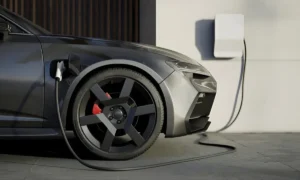The electric revolution is here—and it’s charging right from your doorstep. With electric vehicles (EVs) becoming mainstream in India, one of the most common questions people ask is: “Can electric vehicles be charged at home?”
The answer is yes, and it’s simpler than you might think. Home charging is not just possible—it’s convenient, cost-effective, and increasingly necessary for EV owners seeking daily mobility without the hassle of public charging queues.
In this blog, we’ll dive deep into how you can charge your electric vehicle at home, the different charger options available, installation procedures, electricity costs, and smart tips to optimize your charging setup—especially in the Indian context.

Understanding Home EV Charging
Before we get into the “how,” let’s understand what home EV charging actually means.
Charging an EV at home simply involves connecting your vehicle to an EV charger installed in your home or parking area that draws electricity from your existing power supply.
Home EV charging solutions typically come in two forms:
- AC Chargers (Alternating Current) — Perfect for residential use.
- DC Chargers (Direct Current) — Generally used for commercial or fast-charging setups.
Types of EV Chargers for Home
If you’re wondering what kind of charger you can install at home, here’s a quick breakdown:
1. AC EV Chargers
- Power Output: 3.3kW to 22kW
- Best For: Daily overnight charging
- Charging Time: 6–8 hours for a full charge
- Ideal Users: Individual car owners
Celectric Mobility manufactures AC chargers specifically designed for home use. They are compact, safe, and compatible with most electric cars available in India.
2. DC EV Chargers
- Power Output: 30kW and above
- Best For: Commercial/public charging
- Charging Time: 30–60 minutes for a full charge
- Ideal Users: Businesses, fleet operators, and commercial parking zones
While DC chargers are mostly installed at public charging stations, high-end homeowners and businesses with large vehicles may also consider DC chargers for private use.
How to Charge an Electric Vehicle at Home
Step 1: Choose the Right Charger
Start by identifying your vehicle’s compatible charger type. Celectric Mobility provides a range of home EV chargers suited for different car models and power needs.
Step 2: Check Your Power Supply
Ensure your home’s electrical system supports the load. In India, a 16A–32A connection is typically sufficient for AC chargers.
Step 3: Professional Installation
Never attempt DIY installation. A certified technician should handle setup, grounding, and safety checks. Celectric Mobility’s installation partners provide complete assistance from start to finish.
Step 4: Connect and Charge
Once installed, simply plug your EV into the charging port. The charger communicates with your vehicle to manage power flow and automatically stops charging when the battery is full.

Cost of Charging an EV at Home in India
Charging costs vary depending on your electricity tariff and charger efficiency. Here’s a general estimate:
| Parameter | Value |
| Average Electricity Rate | ₹6–₹8 per kWh |
| EV Battery Capacity | 30–40 kWh |
| Full Charge Cost | ₹180–₹320 |
| Range per Charge | 250–400 km |
That means you can drive your EV for as little as ₹1 per km, compared to ₹6–₹10 per km for petrol or diesel vehicles—making home EV charging not just convenient but economically smart.
Installation Requirements for Home EV Chargers
Installing an EV charger at home doesn’t require major infrastructure changes, but you should consider the following:
- Dedicated Circuit: Prevents overloading your household supply.
- Proper Earthing: Ensures electrical safety.
- Weatherproofing: For outdoor installations.
- Smart App Integration: Celectric’s mobile app allows you to monitor energy consumption, schedule charging, and track costs in real-time.
Smart Charging: The Future of Home EV Charging
With the rise of connected technology, home EV chargers are becoming smarter.
Features of Smart EV Chargers by Celectric:
- Remote monitoring through mobile apps
- Scheduled charging during off-peak hours
- Real-time energy usage reports
- Auto-cutoff for battery protection
These features make it easy for EV owners to save electricity, extend battery life, and reduce costs—all from their smartphones.
Environmental and Financial Benefits
Charging your EV at home isn’t just about convenience—it’s about sustainability and long-term savings.
Environmental Benefits
- Zero tailpipe emissions
- Lower carbon footprint
- Supports India’s EV adoption targets under FAME II
Financial Benefits
- Lower running costs compared to fossil fuels
- Minimal maintenance
- Government subsidies on EV chargers and installations in select states
By switching to a home EV charging setup, you’re directly contributing to a cleaner, greener India.
Can You Charge an EV from a Regular Socket?
Technically, yes—you can use a standard 15A socket to charge your EV, but it’s not recommended for long-term use.
Regular sockets lack the safety and efficiency of a dedicated EV charger. They:
- Take longer to charge (12–14 hours or more)
- Can overheat with prolonged use
- Don’t offer surge or overcharge protection

For safety and efficiency, it’s always better to install a certified home EV charger.
🇮🇳 Government Support and Policies in India
The Indian government is actively promoting through initiatives like:
- FAME II Scheme: Subsidies for EV charging infrastructure.
- State EV Policies: Delhi, Maharashtra, and Tamil Nadu offer rebates for home charger installations.
- DISCOM Collaboration: Several electricity boards provide discounted rates for EV charging connections.
Celectric Mobility aligns its solutions with these policies to make home charging accessible and affordable for every EV owner.
Why Home EV Charging Is the Future
By 2030, India is projected to have over 10 million electric vehicles on the road. With such growth, home charging will become the default mode for daily EV users.
Businesses investing in EV charging infrastructure now are positioning themselves for a profitable, sustainable future—while individuals benefit from long-term cost savings and convenience.
Quick Summary
| Question | Answer |
| Can electric vehicles be charged at home? | Yes, easily using an AC or DC home charger. |
| Is home charging safe? | Yes, when installed by certified professionals. |
| How long does it take? | 6–8 hours with an AC charger. |
| Is it cost-effective? | Yes, it’s 70–80% cheaper than petrol/diesel. |
| Do I need government approval? | Usually not, but check local EV policies. |
FAQs
1. What is the best EV charger for home use?
AC chargers are best for home use as they are affordable, safe, and efficient for overnight charging.
2. How much does it cost to install a home EV charger in India?
On average, installation costs range from ₹15,000 to ₹40,000, depending on the charger type and wiring setup.
3. Can I install more than one charger at home?
Yes, multiple chargers can be installed, provided your home’s power capacity allows it.
4. Does Celectric Mobility offer installation support?
Yes, Celectric provides complete installation assistance across India, ensuring safety and compliance.
5. Can solar power be used for EV home charging?
Absolutely. Integrating solar panels with your home EV charger can make your charging setup 100% green and cost-free over time.
Final Thoughts: Power Up Your EV Journey with Celectric Mobility
So, can electric vehicles be charged at home?
Absolutely—and Celectric Mobility makes it easier than ever.
Whether you need an AC charger for your home or a DC fast charger for your business, Celectric provides end-to-end solutions—manufacturing, installation, and smart monitoring—all under one roof.
Take charge of your future.
Visit www.celectricmobility.com today to explore smart, sustainable, and efficient EV charging solutions.

